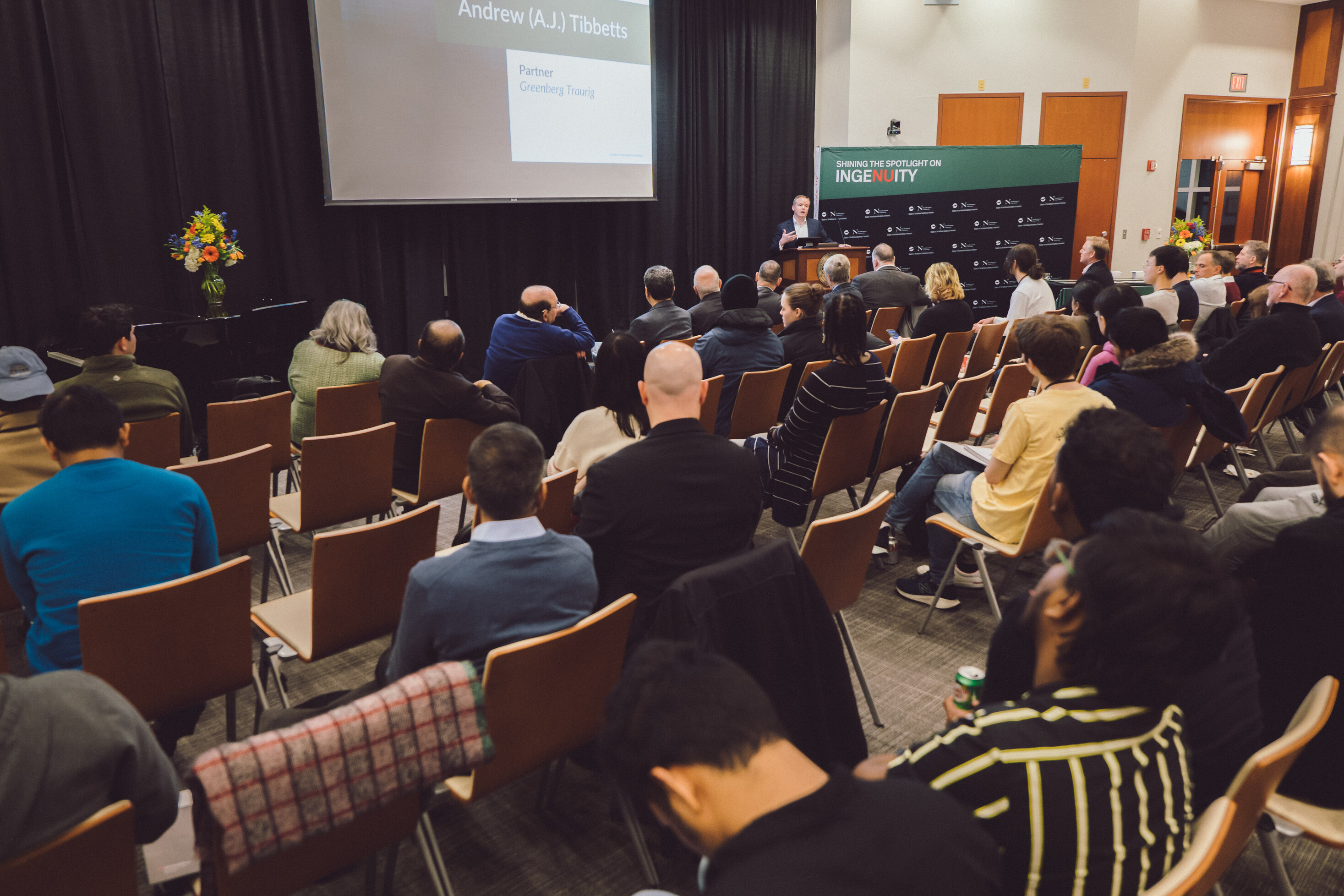 As a globally renowned research institution, Northeastern is a hub for academic excellence and a catalyst for transformative innovations and discoveries. Last year marked a significant milestone as the Center for Research Innovation (CRI) launched Northeastern’s National Academy of Inventors (NAI) chapter, striving to amplify the university’s innovative impact on the Boston campus and beyond.
As a globally renowned research institution, Northeastern is a hub for academic excellence and a catalyst for transformative innovations and discoveries. Last year marked a significant milestone as the Center for Research Innovation (CRI) launched Northeastern’s National Academy of Inventors (NAI) chapter, striving to amplify the university’s innovative impact on the Boston campus and beyond.
The creation of the NAI chapter aligns with Northeastern’s trajectory as an increasingly global force of innovation. The chapter serves as a pivotal link, connecting Northeastern to the NAI’s global network of 46 active chapters and over 2,500 individual members.
On January 18, 2024, the chapter convened its second annual meeting at the Egan Center Raytheon Amphitheater. Gathering experts from academia and industry to discuss the latest in artificial intelligence (AI) technology and patent law, the meeting was an opportunity to hear from industry experts, share information, and get inspired by the collaborative efforts that continue to define Northeastern’s commitment to innovation on a broader scale. The meeting also celebrated the chapter’s new members and recognized select members for their recent accomplishments.
Northeastern NAI Chapter annual meeting
Opening remarks
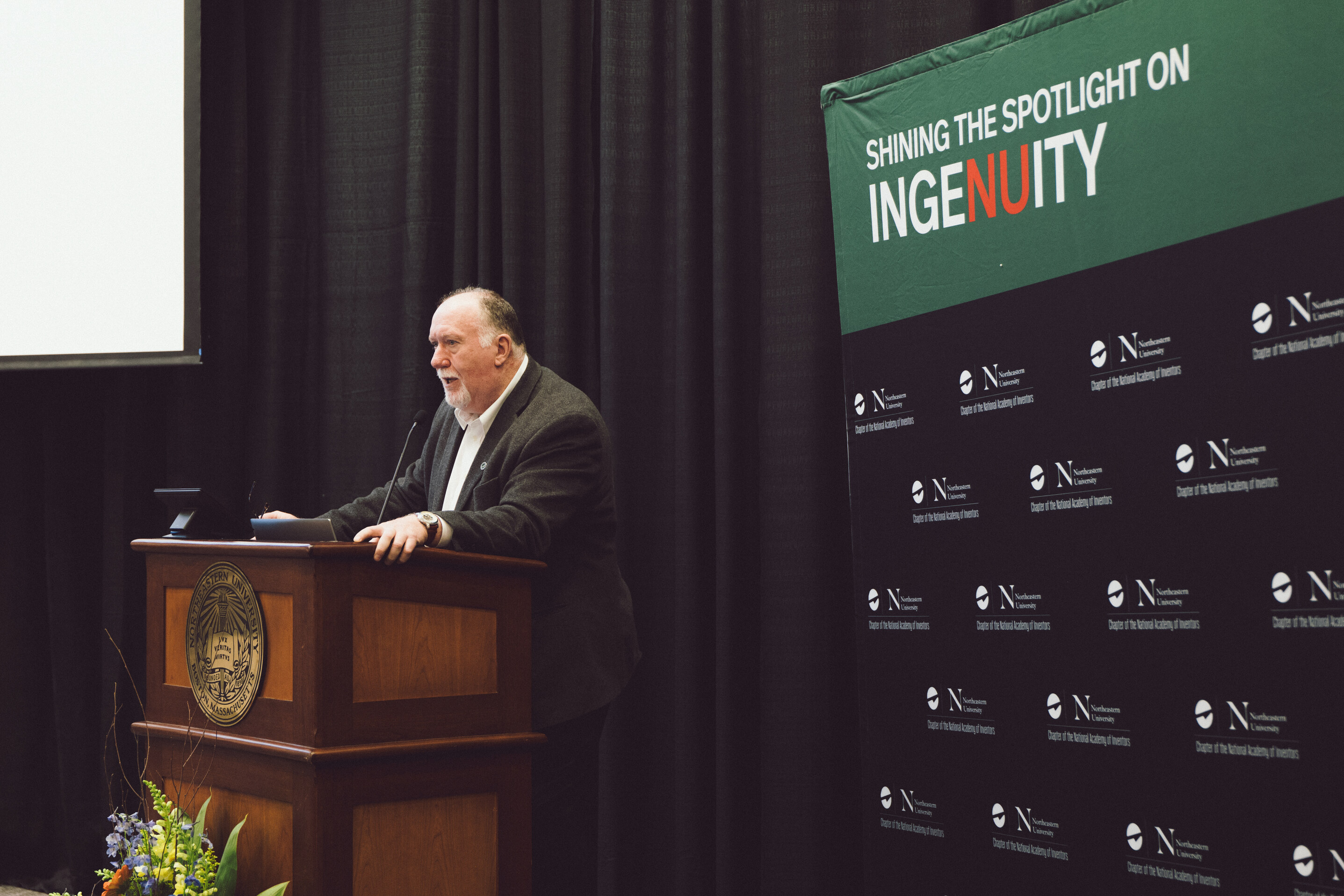 The annual meeting included opening remarks from Vincent Harris, Distinguished Professor and Co-Chair of the Executive Committee for the NAI Northeastern Chapter.
The annual meeting included opening remarks from Vincent Harris, Distinguished Professor and Co-Chair of the Executive Committee for the NAI Northeastern Chapter.
“The mission of Northeastern’s NAI chapter is to embrace our century-long leadership in experiential education, translational research, and global presence,” says Harris. “The Northeastern chapter of the NAI serves to empower inventorship and entrepreneurship across our innovation ecosystem by recognizing, inspiring, educating, and connecting members of the academic and industrial community.”
Keynote remarks
 Steve Johnson, Senior Fellow at Northeastern’s Institute of Experiential AI, gave keynote remarks.
Steve Johnson, Senior Fellow at Northeastern’s Institute of Experiential AI, gave keynote remarks.
Johnson recalled how his path to becoming an inventor was not “traditional,” as he studied music and math at the University of Southern California and public policy and philosophy at Harvard. After graduating in 1990 at the age of 31, Johnson attended a fateful dinner with Dr. Irving Reed, a renowned electrical engineering professor from USC who is best known for his Reed Solomon error correction code, used to secure information in digital systems.
Per a suggestion from Star Wars creator George Lucas, Reed suggested Johnson should focus on digital image compression, as it had potential as an upcoming technology for applications such as movie showings. The idea was that, with the appropriate algorithm, a picture could be represented with fewer bits, transmitted faster, and stored more efficiently.
“I was hooked,” said Johnson. “I was an economist trained at Harvard to think about world problems, like nuclear war, but I had kept up my computer skills as a hobby. I had just enough experience to think I could conquer this problem.”
If you’ve ever opened a webpage and seen a blurry photo for a few seconds while the photo loads until it suddenly becomes a pristine image, you’ve experienced the results of this work. In the early 90s, Johnson worked to develop an algorithm that could compress an image so it could be transmitted in just seconds (when it would previously take an hour during the early age of dial-up internet).
After being unable to hook any venture capitalists, Johnson partnered up with investment banker Steve Case, then the CEO of America Online. In January 1994, Johnson Grace won the contract to build image compression into AOL. Their work was later showcased as AOL featured online versions of Newsweek and Time magazine pages that resembled their print counterparts.
“It was an astonishing breakthrough to AOL and the world,” said Johnson. “Transmitting pages with pictures over a network in only seconds was like listening to the radio for the first time. The impact was truly magical.”
In 1996, his team patented their technology for the acquisition, and AOL bought Johnson Grace.
Johnson acknowledges that his success could be considered a rare example; he encourages inventors to keep going and keep experimenting as long as they can.
“Until the day AOL acquired us, we had no idea how extraordinarily valuable this set of ideas would become. We were still debating whether the Internet was just a fad,” said Johnson. “But we inventors don’t consult actuarial tables of the probabilistic outcomes of our garage musings because they don’t exist. But we don’t care because we know we can do it.”
Intellectual property insights and best practices
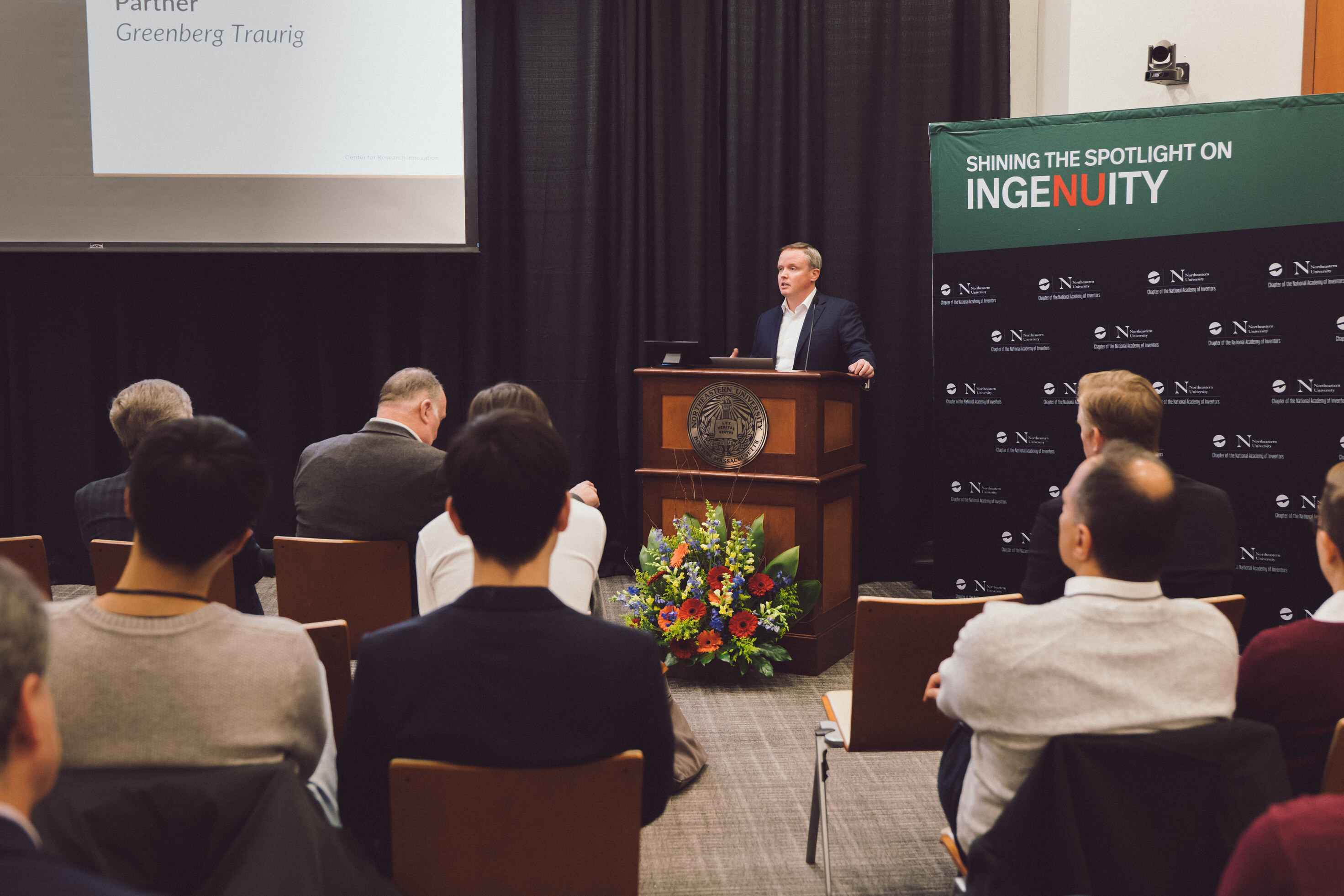 Next, AJ Tibbetts, industry expert and Partner at Greenberg Traurig, gave remarks about intellectual property (IP), providing insights on best practices for inventors and how AI impacts IP.
Next, AJ Tibbetts, industry expert and Partner at Greenberg Traurig, gave remarks about intellectual property (IP), providing insights on best practices for inventors and how AI impacts IP.
“A patent is not a trophy,” advised Tibbetts. “It’s not your gold star for having had a great idea. It’s a business asset.” Therefore, inventors need to determine how they define their business, what downstream impacts their invention could have, how that invention could be implemented, and lastly, how to craft a patent to cover those downstream results.
Next, Tibbetts discussed some intricacies and lesser-understood facts about determining patent ownership, public disclosure obligations, and best practices for patentability searching.
“If you’re considering commercializing an idea, be sensitive to who is helping you develop that idea,” he said. “Those people might be friends happy to contribute at the time, but when somebody shows up with a giant check to acquire your idea later, they may have a different feeling.”
AI and entrepreneurship: creating a spinout company at Northeastern
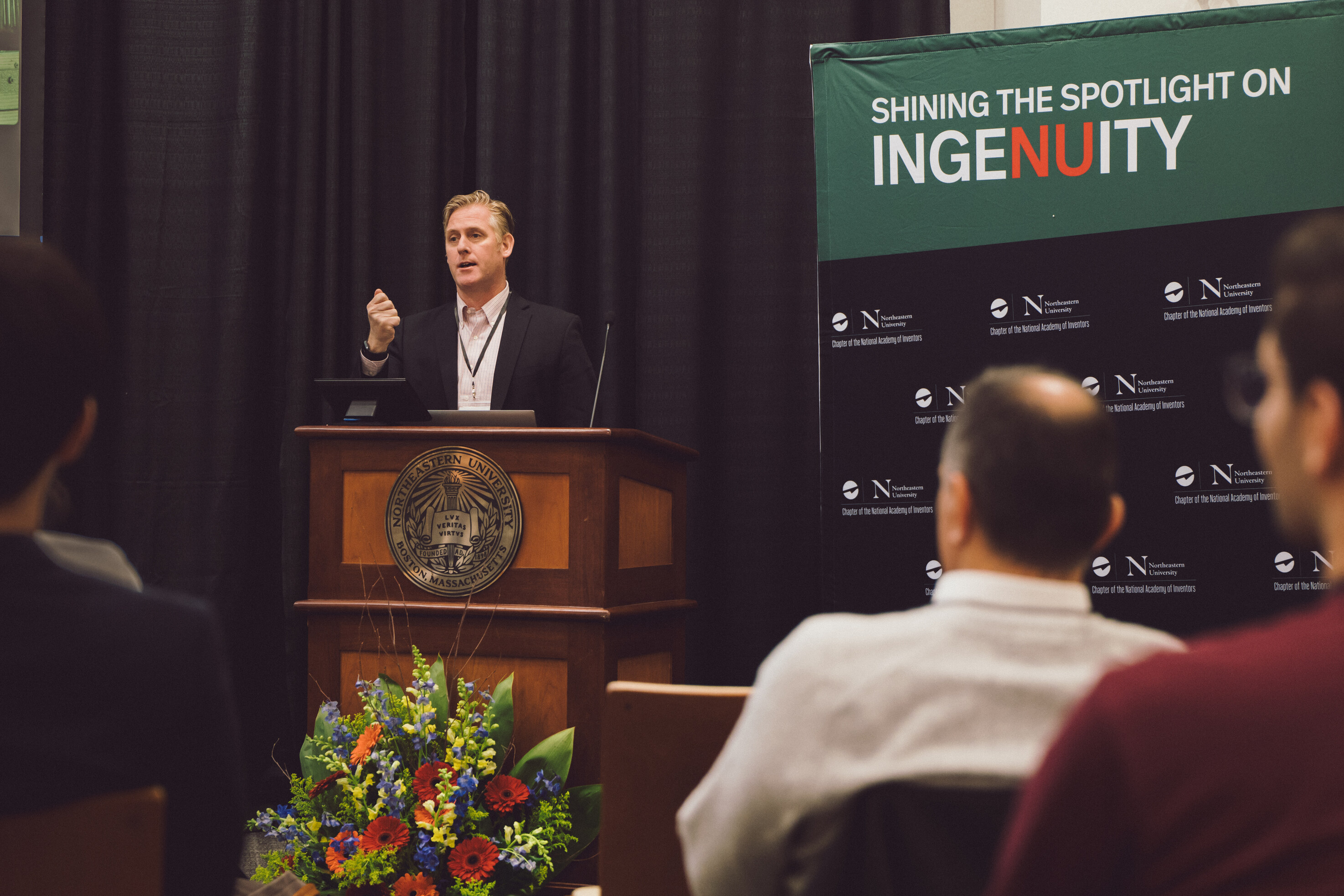 Next, Tucker Marion, Faculty Entrepreneur and Cofounder of Northeastern spinout ADATech shared insights on the process of forming a spinout company from work started at Northeastern and how the CRI has helped facilitate their success.
Next, Tucker Marion, Faculty Entrepreneur and Cofounder of Northeastern spinout ADATech shared insights on the process of forming a spinout company from work started at Northeastern and how the CRI has helped facilitate their success.
ADATech leverages AI to expedite product design decisions. Addressing the persistent 40% failure rate in product development, the company aims to streamline workflows for designers and managers, emphasizing the need for improved customer insight integration.
The company focuses on two key objectives: making informed decisions and significantly reducing time and cost to market. This involves AI-driven data analysis, predicting customer sentiment on specific product attributes, and employing generative AI for concept development, leading to better-designed products.
Reflecting on how he navigated intellectual property challenges within the university setting, Marion spoke to the careful balance of needing to release academic research information through presentations and papers while protecting potential IP.
“Part of being a university-backed project funded by the National Science Foundation means we had to present at conferences. The challenge is that we don’t want to present a paper and publish a model that can be reproduced, therefore losing any potential intellectual property.”
Furthermore, he discussed how transitioning from academic research to a viable company requires assembling a dedicated team outside the university and securing funding. The CRI was a crucial ally for him in these areas, offering support through programs like the Entrepreneur-in-Residence initiative and providing grant funding.
“We became increasingly engaged with the CRI,” said Marion. They’ve done an excellent job experimenting with new ways to mentor, foster, and incubate companies like ours.”
The successful spinout of the company, now equipped with a leadership team, showcases the transformative power of transitioning from academic research to a tech venture with the backing of university support.
Member Recognition and Closing Remarks
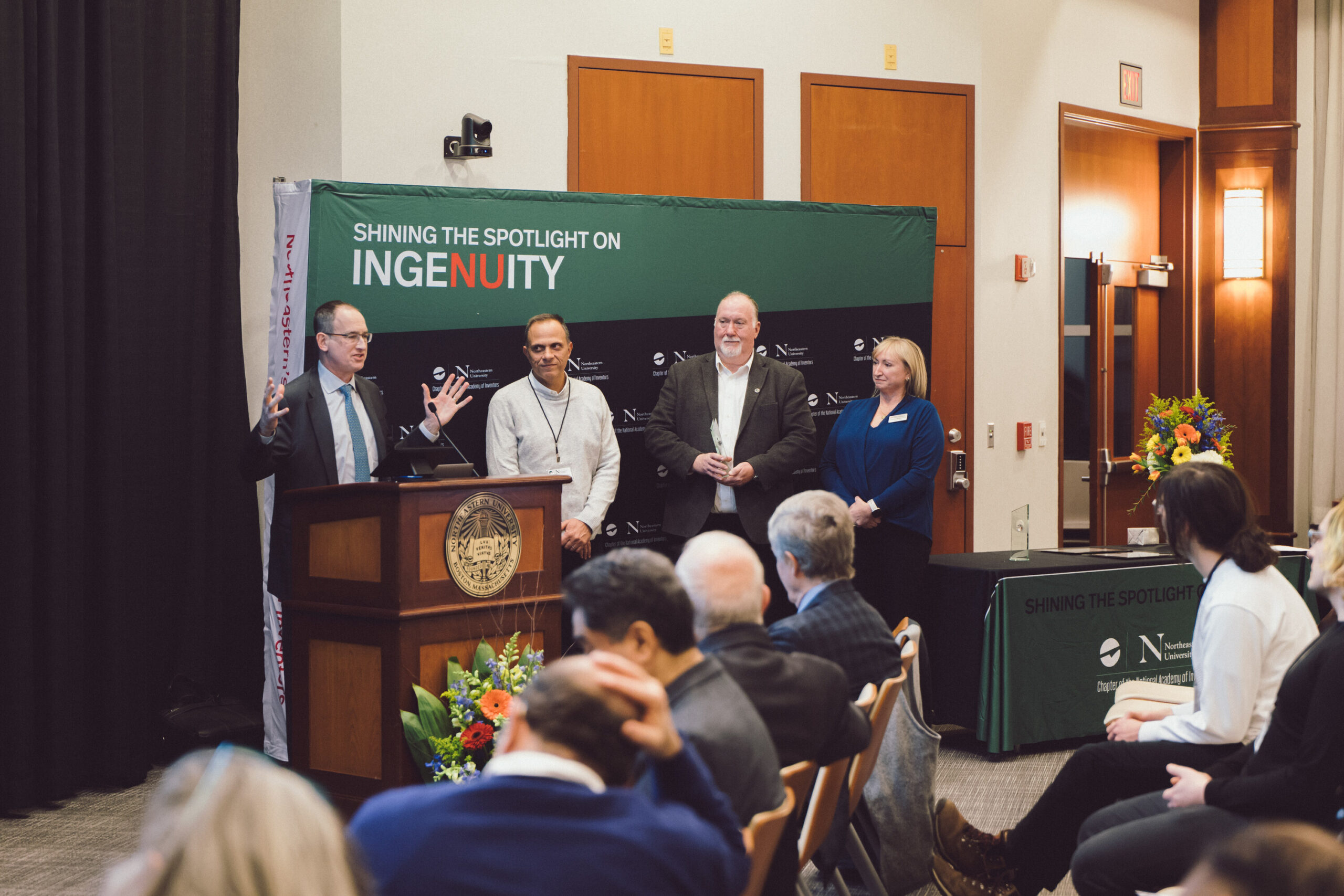 The evening ended with closing remarks from Ken Blank, NAI Fellow and Senior Advisor to Northeastern, and David Luzzi, Northeastern Senior Vice Provost for Research.
The evening ended with closing remarks from Ken Blank, NAI Fellow and Senior Advisor to Northeastern, and David Luzzi, Northeastern Senior Vice Provost for Research.
Blank and Luzzi helped recognize the 2023 Class of NAI Fellows, Yun Raymond Fu and Srinivas Sridhar, and welcomed new and honorary members to the Northeastern NAI chapter.
Lastly, the chapter proudly presented the inaugural Northeastern NAI Innovator of the Year awards. The awards recognize one faculty member and one student who exhibited exceptional inventiveness to advance theoretical and practical understanding and gain deeper insight into significant problems, devised keen solutions that derive benefit in their field of expertise and across multiple spheres of life, and give back to the community by cultivating a spirit of innovation, mentorship, and motivation.
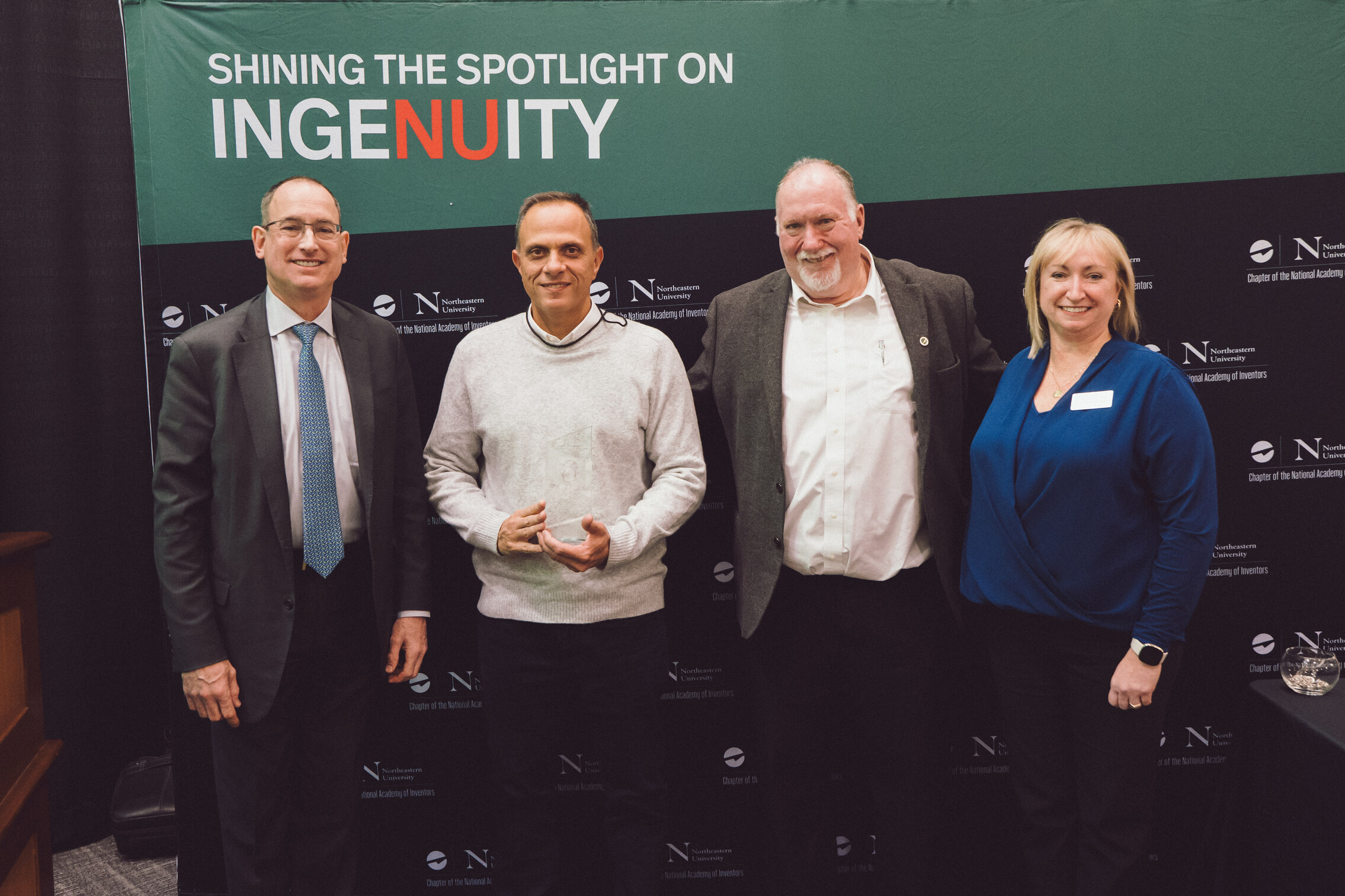
The Northeastern NAI Chapter Innovator of the Year award was given to Professor Meni Wanunu of the College of Engineering and the College of Science.

The Northeastern NAI Chapter Student Innovator of the Year award was given to Daniel Braconnier, a recent Ph.D. graduate of the College of Engineering.
How to get involved with the Northeastern NAI Chapter
Northeastern’s NAI chapter is always accepting new faculty and student members. While full members of NAI are required to have authored at least one patent, there is no requirement for student members. Any students curious about innovation, entrepreneurship, and commercialization are encouraged to join.
In addition to membership, the NAI chapter is proud to offer fellowships — a high professional distinction for academic inventors.
The NAI chapter serves as a vehicle to nurture research innovation and entrepreneurship across the global network. Northeastern’s NAI chapter supports researchers and inventors by promoting their work and encouraging connections. The chapter helps members network, collaborate, and create mentor relationships with other students and faculty. The NAI chapter also creates entrepreneurial and commercialization opportunities by engaging new commercial partners and connecting members to chapters at peer universities. The chapter’s overall goal is to bring like-minded innovators of all levels of experience together to share ideas, resources, and knowledge.
Throughout the year, the NAI chapter hosts workshops, annual recognition events, networking events, quarterly meetings with inspirational speakers from industry, and seminars on IP creation, management, and protection that members of the Northeastern community are encouraged to attend.
You can apply to be a chapter member, serve as a board or committee member, or support and attend events throughout the year. Visit our website for more info on the Northeastern NAI chapter and stay tuned for future updates.
Click here to watch the full video of the event
Written by Elizabeth Creason
